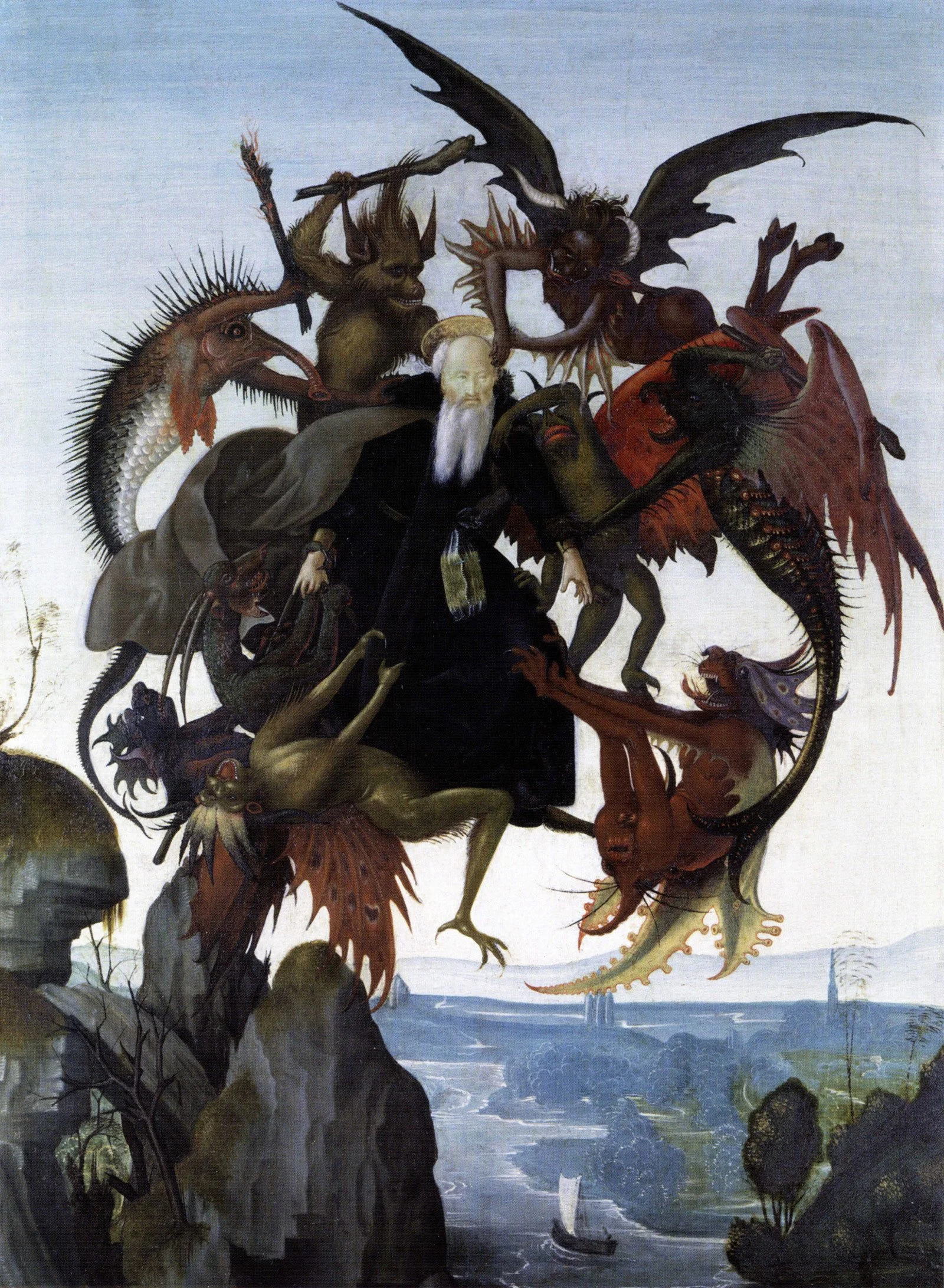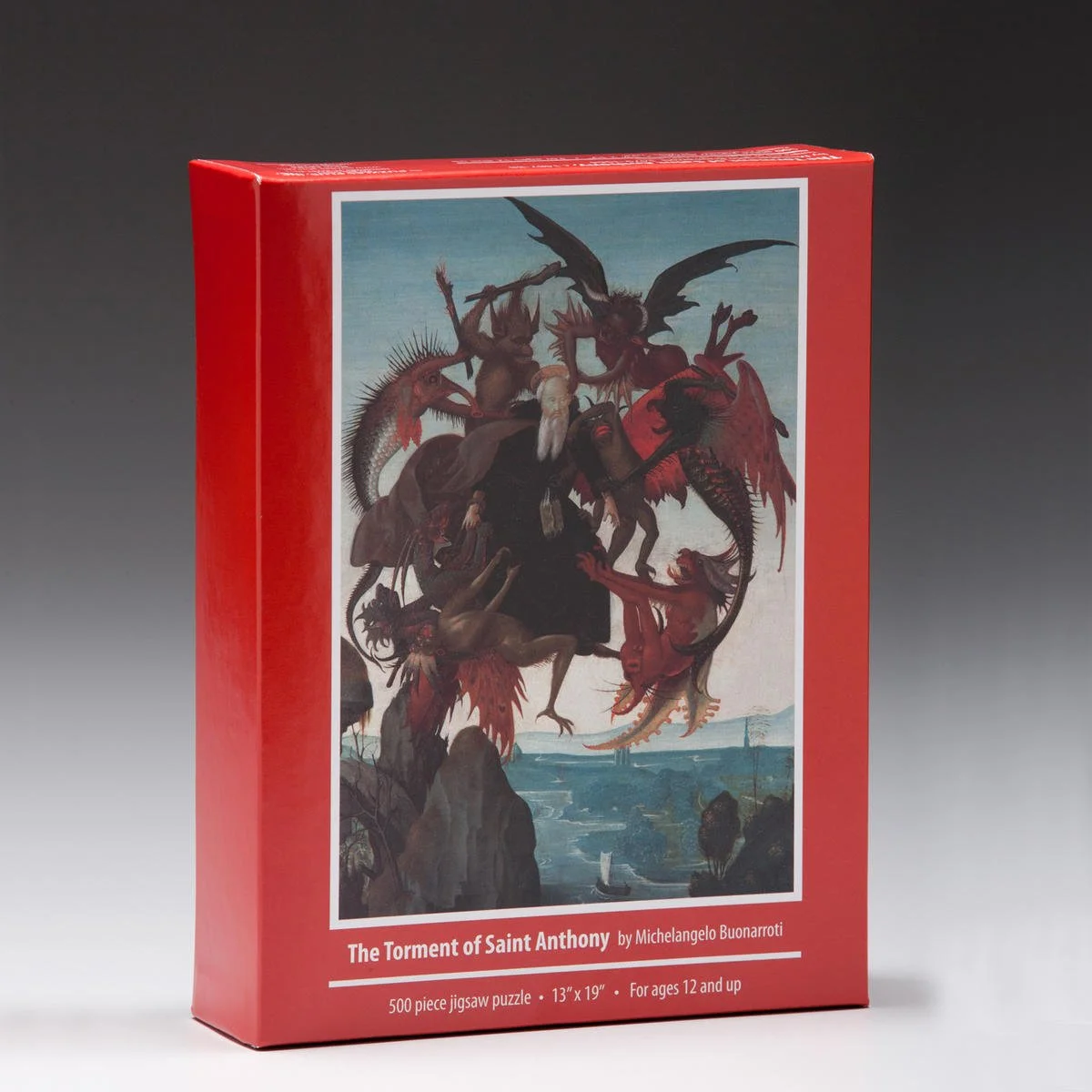Martin Schongauers “Heiliger Antonius von Dämonen gepeinigt”
Immer noch ikonografisch weitestgehend falsch als “Versuchung des Heiligen Antonius” bezeichnet, handelt es sich bei dem Kupferstich von Martin Schongauer um eines der zahlreich und bis heute in unterschiedlichsten Varianten kopierten Werke der Kunstgeschichte. Erstaunlich in der Komposition wird der Heilige im Luftraum inmitten einer Schar von Dämonen und Quälgeistern präsentiert.
In meiner Dissertation ging ich im zweiten Teil (Seite 75 - 246) auf dieses Werk ein. Michelangelo habe als erstes malerisch-zeichnerisches Werk genau diese Druckgrafik kopiert und sich bemüht seine Kopie so naturgetreu wie möglich auszuführen. Darin habe er bereits als Dreizehnjähriger seinen Lehrmeister Domenico Ghirlandaio übertroffen. Dies ist wohl ein Topos der frühen Kunstliteratur, aber es steckt viel mehr dahinter. Da eine Tafel in Fort Worth in Texas erhalten ist, die in einem Ghirlandaio ähnlichen Stil gemalt wurde (siehe Abbildung zwei der Slideshow oben), behauptet die amerikanische Kunstkennerschaft, dass es sich dabei um das erste Werk Michelangelos handle. Ich analysierte die Plausibiltäten für und gegen eine Zuschreibung dieser Arbeit, war jedoch faszinierter von der Tatsache der Erwähnungen einer solchen in allen zu Lebzeiten des Künstlers veröffentlichten Lebensbeschreibungen. Aus diesem Interesse heraus begann ich mich über Jahre intensiv mit dieser Druckgrafik zu befassen.
So konnte ich ergründen wie Schongauer seine Formensprache der Fantasiewesen aus den Falten des aufgewehten Umhang des Heiligen entwickelte oder zumindest mit jenem synchronisierte (siehe Abbildungen in der Slideshow). Der formale Wille zur Vereinheitlichung und zur Zentrierung der Figurengruppe ist nicht zu übersehen. Dies ist mitunter auch ein Aspekt, der Michelangelo als Bildhauer interessiert haben könnte.
Darüber hinaus konnte ich nachweisen, dass es sich um einen anderen Moment aus der von Athanasios verfassten Vita des Heiligen handeln muss als bisher angenommen. Der Heilige wird hier zuerst von Engeln zu Gott getragen, jedoch dann von dämonischen Kräften zurück zur Erde geführt. Obwohl noch im sphärischen Luftraum gehalten, wird der Schweif des auf der rechten Seite nach unten ziehenden Dämons subtil von einem dunklen Stein kontrastiert und so geerdet.
…
Derzeit erarbeite ich ein genaue Studie zu Schongauers Druckgrafik. Die Abbildungen geben, neben meiner Dissertation, einen ersten Einblick in meine Methodik.
…
Link zum pdf der Dissertation, 2016: Dissertation zu Michelangelo
(English version below)
English version: Martin Schongauer's "Saint Anthony tormented by demons".
Still iconographically widely mislabelled as the "Temptation of Saint Anthony", this copperplate engraving by Martin Schongauer is one of the numerous works in art history that has been copied and interpreted in a wide variety of ways up to the present day. Astonishing in its composition, the saint is presented in the air amidst a host of demons and tormentors.
In the second chapter of my dissertation I dealt with this artwork (pp. 75 - 246). Michelangelo copied exactly this print as his first pictorial work and tried to make his reproduction as life-like as possible. Here, at the age of thirteen, he surpassed his teacher Domenico Ghirlandaio. Though this is probably a topos of early art literature, there is a much more to it than that. As a panel has survived in Fort Worth, Texas, painted in a style similar to Ghirlandaio's (see figure two of the slideshow above), American art connoisseurs claim that it is Michelangelo's first work. I considered the plausibilities for and against the attribution of this work, but was more intrigued by the fact of the mentions of the work in all the biographies published during the artist's lifetime. Based on this interest, I began to study the print intensively over many years.
The result was that I was able to fathom how Schongauer developed his formal language of fantasy creatures from the folds of the saint's woven cloak, or at least synchronised it with the cloak (see illustrations in the slideshow). The intention to unify and centre the group of figures formally cannot be overlooked. Certainly, this is an aspect that interested Michelangelo as a sculptor.
Furthermore, I proved that the moment in question has to be a different scene from the saint's vita written by Athanasios than previously assumed. Here, the saint is first carried to God by angels, but then drawn back to earth by demonic forces. Although still held in spherical airspace, the tail of the demon on the right side pulling the Antony down is subtly contrasted by a dark stone and thus grounded.
...
I am currently working on a detailed study of Schongauer's prints. The illustrations, alongside my dissertation, provide a first view of my methodology.
















